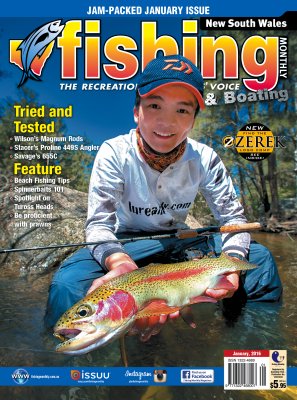Ten beach fishing tips by Jamie Robley
 The coming months normally provide first-rate beach fishing right along the NSW coastline. Quite a few species are on offer as well, including bream, whiting, tailor, salmon and mulloway. Unlike mid to late winter, coastal water temperature remains very comfortable too, so feet don't end up frozen, even when autumn starts kicking in.
The coming months normally provide first-rate beach fishing right along the NSW coastline. Quite a few species are on offer as well, including bream, whiting, tailor, salmon and mulloway. Unlike mid to late winter, coastal water temperature remains very comfortable too, so feet don't end up frozen, even when autumn starts kicking in.
As with all forms of angling, a number of different factors are involved to bring success on the sand. There aren't just one or two key points or any sort of closely guarded secrets. Rather, success comes from a combination of tackle, technique, common sense and good luck that adds up to fun times and perhaps a tasty seafood dinner at the end of the day.
GEARING UP
One of the most proficient beach anglers I've ever seen used only an old plastic coke bottle, with 100m of line wrapped around it to cast small baits into the North Coast surf, for bream, whiting and flathead. While I'm certainly not about to recommend a coke bottle as your main weapon at the beach, it simply shows that expensive or sophisticated tackle isn't a major requirement.
However, it is definitely beneficial to use a lightweight, balanced outfit of reasonable quality. A good starting point for rod length is 3m or 10ft, with an extra half metre performing better in some cases. In more sheltered stretches, where the surf is only small, much shorter rods can also be fun and practical to use.
Simple, decent quality threadline reels, spooled up with mono, rather than braid, are easy to use and get the job done, without problems. Of course, Alvey sidecast reels are practical and durable for the beach, although probably not as easy to use as threadlines or 'eggbeaters' for kids or less experienced anglers. Either way, try to buy the best the budget allows and avoid dropping them in the sand, if possible.
If a reel does end up taking a swim in the surf or gets covered in sand, give it a hose with freshwater at the very first opportunity and brush off the sand with a toothbrush or small cleaning brush. If it feels clogged or very rough to wind, then it probably needs a full service. If not, then perhaps a light spray with Inox or WD40, then a few drops of oil around the working parts will be enough to get it back in order and ready to fish again. Remember to wipe off any oil or residue around the reel, as this attracts more sand and grime.
As for lines, the simplicity and stretch of nylon mono can be preferable to the more modern braids or PE line for surf fishing, and a must if a sidecast reel is used. However, braids can make for better casting distance and greater bite sensitivity. When you use braid, it's important to also use a nylon leader, to avoid bust-offs or fish shaking the hooks free. Of course, this means there are more knots to tie and things start to become a bit more complicated.
Other items like a small plastic bucket with a lid, a carry bag, compact tackle box, knife, pliers and a rag or cloth to wipe your smelly hands or the rod are also essential. Bear in mind, the lighter the kit is the easier and more enjoyable the beach fishing experience will be.
PLANNING
Well before heading to the nearest beach, it makes sense to check weather, sea and tide forecasts, even up to a week or more in advance, particularly if a long trip is in mind. Strong wind or rough seas could mean things are going to be problematic and perhaps not even worth trying. Reasonably good, stable weather is generally your best bet.
Other aspects of planning may involve securing some good quality bait, arranging plans with other anglers or perhaps doing some further research into a certain species or location.
TIME AND TIDE
Most fish bite best as the tide is rising at the beach. Sometimes the bottom of the tide may be a good time to start, while other times it may be better to concentrate more an hour either side of the top of the tide. Each beach and species is a little different, so it may take some experimentation to work out what's best. If in doubt, the few hours leading up towards high tide are generally productive for most fish at most beaches.
If the tidal phase can be timed to coincide close to sunrise or sunset, the fishing will be even better. Like most fish in any sort of salt or freshwater environment, the low light periods that last an hour or so are when many fish are actively seeking food. Some fish, like mulloway and tailor, bite really well through the night as well, but it's still important to time outings with the tides.